Apoorv Vyas
Pushing the Frontier of Audiovisual Perception with Large-Scale Multimodal Correspondence Learning
Dec 22, 2025Abstract:We introduce Perception Encoder Audiovisual, PE-AV, a new family of encoders for audio and video understanding trained with scaled contrastive learning. Built on PE, PE-AV makes several key contributions to extend representations to audio, and natively support joint embeddings across audio-video, audio-text, and video-text modalities. PE-AV's unified cross-modal embeddings enable novel tasks such as speech retrieval, and set a new state of the art across standard audio and video benchmarks. We unlock this by building a strong audiovisual data engine that synthesizes high-quality captions for O(100M) audio-video pairs, enabling large-scale supervision consistent across modalities. Our audio data includes speech, music, and general sound effects-avoiding single-domain limitations common in prior work. We exploit ten pairwise contrastive objectives, showing that scaling cross-modality and caption-type pairs strengthens alignment and improves zero-shot performance. We further develop PE-A-Frame by fine-tuning PE-AV with frame-level contrastive objectives, enabling fine-grained audio-frame-to-text alignment for tasks such as sound event detection.
SAM Audio: Segment Anything in Audio
Dec 19, 2025Abstract:General audio source separation is a key capability for multimodal AI systems that can perceive and reason about sound. Despite substantial progress in recent years, existing separation models are either domain-specific, designed for fixed categories such as speech or music, or limited in controllability, supporting only a single prompting modality such as text. In this work, we present SAM Audio, a foundation model for general audio separation that unifies text, visual, and temporal span prompting within a single framework. Built on a diffusion transformer architecture, SAM Audio is trained with flow matching on large-scale audio data spanning speech, music, and general sounds, and can flexibly separate target sources described by language, visual masks, or temporal spans. The model achieves state-of-the-art performance across a diverse suite of benchmarks, including general sound, speech, music, and musical instrument separation in both in-the-wild and professionally produced audios, substantially outperforming prior general-purpose and specialized systems. Furthermore, we introduce a new real-world separation benchmark with human-labeled multimodal prompts and a reference-free evaluation model that correlates strongly with human judgment.
Meta Audiobox Aesthetics: Unified Automatic Quality Assessment for Speech, Music, and Sound
Feb 07, 2025



Abstract:The quantification of audio aesthetics remains a complex challenge in audio processing, primarily due to its subjective nature, which is influenced by human perception and cultural context. Traditional methods often depend on human listeners for evaluation, leading to inconsistencies and high resource demands. This paper addresses the growing need for automated systems capable of predicting audio aesthetics without human intervention. Such systems are crucial for applications like data filtering, pseudo-labeling large datasets, and evaluating generative audio models, especially as these models become more sophisticated. In this work, we introduce a novel approach to audio aesthetic evaluation by proposing new annotation guidelines that decompose human listening perspectives into four distinct axes. We develop and train no-reference, per-item prediction models that offer a more nuanced assessment of audio quality. Our models are evaluated against human mean opinion scores (MOS) and existing methods, demonstrating comparable or superior performance. This research not only advances the field of audio aesthetics but also provides open-source models and datasets to facilitate future work and benchmarking. We release our code and pre-trained model at: https://github.com/facebookresearch/audiobox-aesthetics
MusicFlow: Cascaded Flow Matching for Text Guided Music Generation
Oct 27, 2024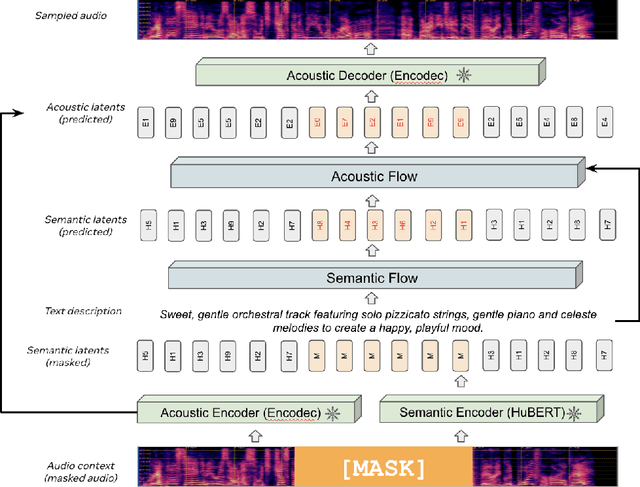

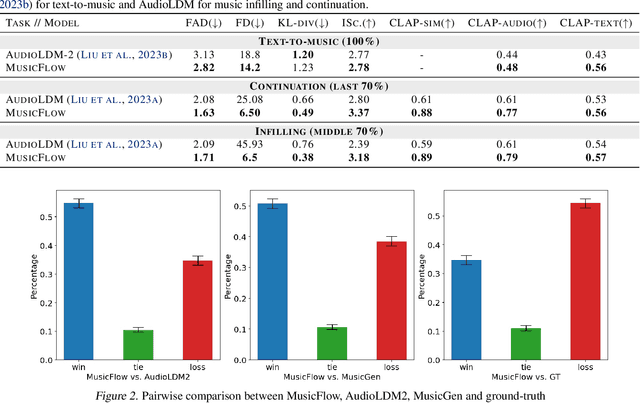
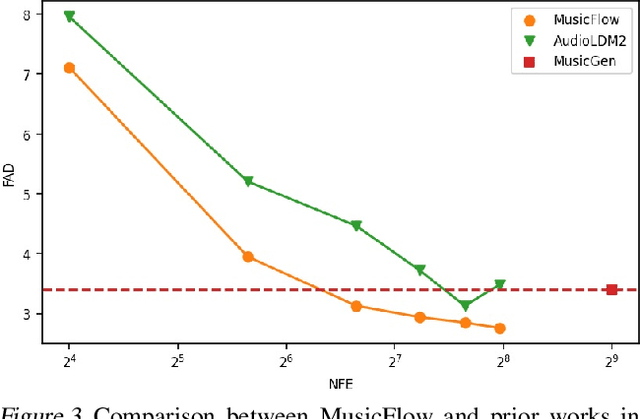
Abstract:We introduce MusicFlow, a cascaded text-to-music generation model based on flow matching. Based on self-supervised representations to bridge between text descriptions and music audios, we construct two flow matching networks to model the conditional distribution of semantic and acoustic features. Additionally, we leverage masked prediction as the training objective, enabling the model to generalize to other tasks such as music infilling and continuation in a zero-shot manner. Experiments on MusicCaps reveal that the music generated by MusicFlow exhibits superior quality and text coherence despite being over $2\sim5$ times smaller and requiring $5$ times fewer iterative steps. Simultaneously, the model can perform other music generation tasks and achieves competitive performance in music infilling and continuation. Our code and model will be publicly available.
Movie Gen: A Cast of Media Foundation Models
Oct 17, 2024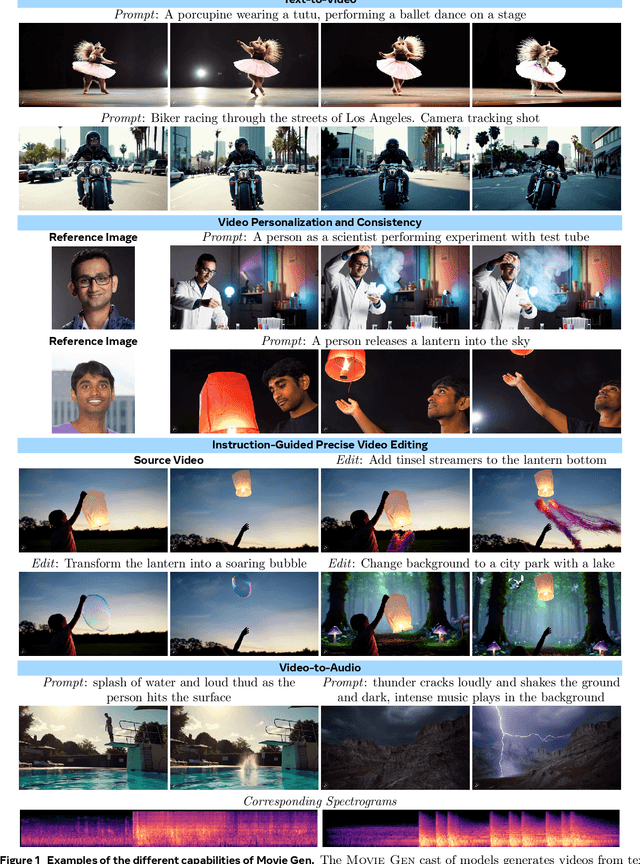

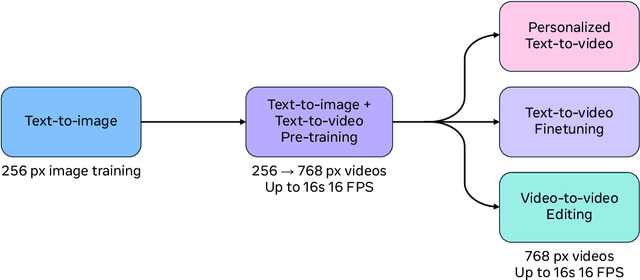
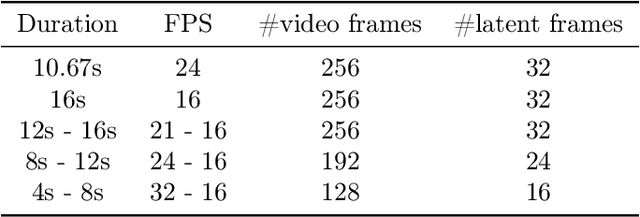
Abstract:We present Movie Gen, a cast of foundation models that generates high-quality, 1080p HD videos with different aspect ratios and synchronized audio. We also show additional capabilities such as precise instruction-based video editing and generation of personalized videos based on a user's image. Our models set a new state-of-the-art on multiple tasks: text-to-video synthesis, video personalization, video editing, video-to-audio generation, and text-to-audio generation. Our largest video generation model is a 30B parameter transformer trained with a maximum context length of 73K video tokens, corresponding to a generated video of 16 seconds at 16 frames-per-second. We show multiple technical innovations and simplifications on the architecture, latent spaces, training objectives and recipes, data curation, evaluation protocols, parallelization techniques, and inference optimizations that allow us to reap the benefits of scaling pre-training data, model size, and training compute for training large scale media generation models. We hope this paper helps the research community to accelerate progress and innovation in media generation models. All videos from this paper are available at https://go.fb.me/MovieGenResearchVideos.
Learning Fine-Grained Controllability on Speech Generation via Efficient Fine-Tuning
Jun 10, 2024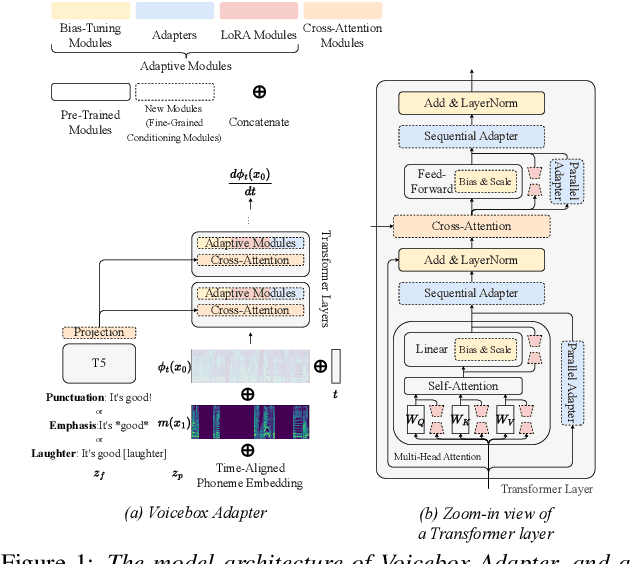
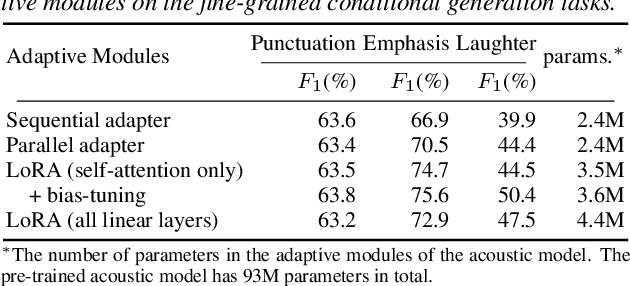

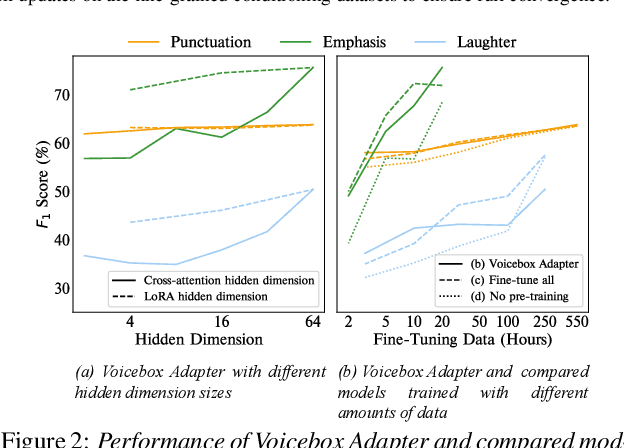
Abstract:As the scale of generative models continues to grow, efficient reuse and adaptation of pre-trained models have become crucial considerations. In this work, we propose Voicebox Adapter, a novel approach that integrates fine-grained conditions into a pre-trained Voicebox speech generation model using a cross-attention module. To ensure a smooth integration of newly added modules with pre-trained ones, we explore various efficient fine-tuning approaches. Our experiment shows that the LoRA with bias-tuning configuration yields the best performance, enhancing controllability without compromising speech quality. Across three fine-grained conditional generation tasks, we demonstrate the effectiveness and resource efficiency of Voicebox Adapter. Follow-up experiments further highlight the robustness of Voicebox Adapter across diverse data setups.
Audiobox: Unified Audio Generation with Natural Language Prompts
Dec 25, 2023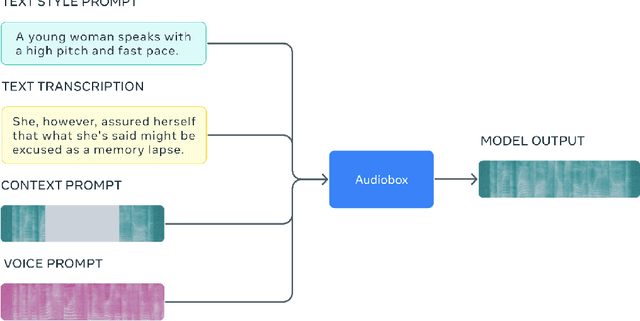

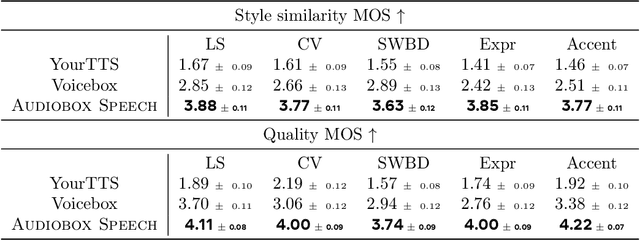
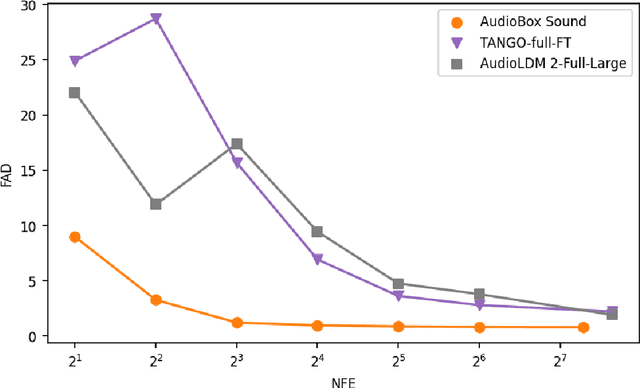
Abstract:Audio is an essential part of our life, but creating it often requires expertise and is time-consuming. Research communities have made great progress over the past year advancing the performance of large scale audio generative models for a single modality (speech, sound, or music) through adopting more powerful generative models and scaling data. However, these models lack controllability in several aspects: speech generation models cannot synthesize novel styles based on text description and are limited on domain coverage such as outdoor environments; sound generation models only provide coarse-grained control based on descriptions like "a person speaking" and would only generate mumbling human voices. This paper presents Audiobox, a unified model based on flow-matching that is capable of generating various audio modalities. We design description-based and example-based prompting to enhance controllability and unify speech and sound generation paradigms. We allow transcript, vocal, and other audio styles to be controlled independently when generating speech. To improve model generalization with limited labels, we adapt a self-supervised infilling objective to pre-train on large quantities of unlabeled audio. Audiobox sets new benchmarks on speech and sound generation (0.745 similarity on Librispeech for zero-shot TTS; 0.77 FAD on AudioCaps for text-to-sound) and unlocks new methods for generating audio with novel vocal and acoustic styles. We further integrate Bespoke Solvers, which speeds up generation by over 25 times compared to the default ODE solver for flow-matching, without loss of performance on several tasks. Our demo is available at https://audiobox.metademolab.com/
Generative Pre-training for Speech with Flow Matching
Oct 25, 2023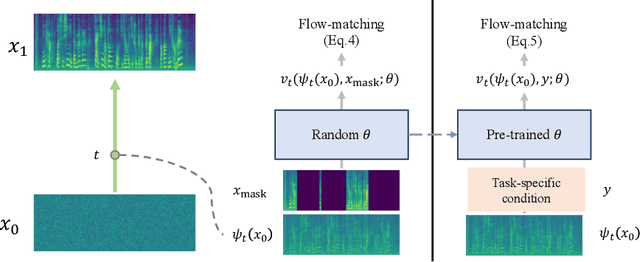
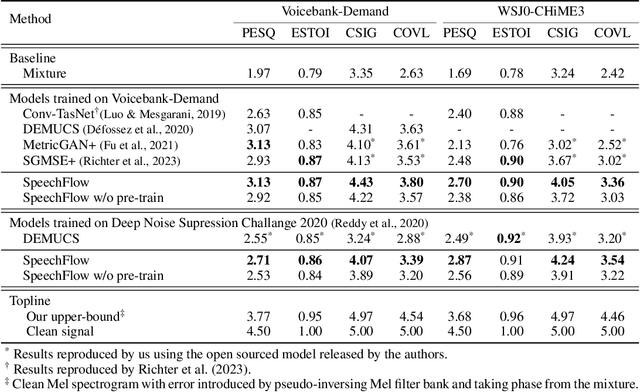
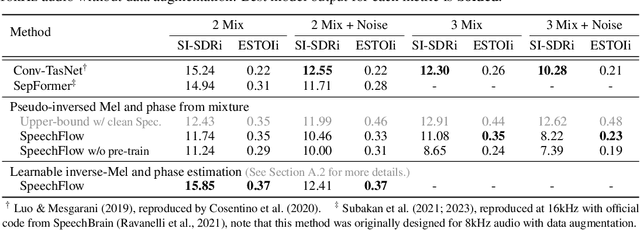
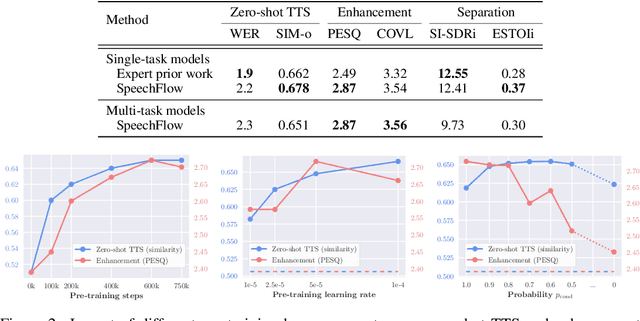
Abstract:Generative models have gained more and more attention in recent years for their remarkable success in tasks that required estimating and sampling data distribution to generate high-fidelity synthetic data. In speech, text-to-speech synthesis and neural vocoder are good examples where generative models have shined. While generative models have been applied to different applications in speech, there exists no general-purpose generative model that models speech directly. In this work, we take a step toward this direction by showing a single pre-trained generative model can be adapted to different downstream tasks with strong performance. Specifically, we pre-trained a generative model, named SpeechFlow, on 60k hours of untranscribed speech with Flow Matching and masked conditions. Experiment results show the pre-trained generative model can be fine-tuned with task-specific data to match or surpass existing expert models on speech enhancement, separation, and synthesis. Our work suggested a foundational model for generation tasks in speech can be built with generative pre-training.
Voicebox: Text-Guided Multilingual Universal Speech Generation at Scale
Jun 23, 2023Abstract:Large-scale generative models such as GPT and DALL-E have revolutionized natural language processing and computer vision research. These models not only generate high fidelity text or image outputs, but are also generalists which can solve tasks not explicitly taught. In contrast, speech generative models are still primitive in terms of scale and task generalization. In this paper, we present Voicebox, the most versatile text-guided generative model for speech at scale. Voicebox is a non-autoregressive flow-matching model trained to infill speech, given audio context and text, trained on over 50K hours of speech that are neither filtered nor enhanced. Similar to GPT, Voicebox can perform many different tasks through in-context learning, but is more flexible as it can also condition on future context. Voicebox can be used for mono or cross-lingual zero-shot text-to-speech synthesis, noise removal, content editing, style conversion, and diverse sample generation. In particular, Voicebox outperforms the state-of-the-art zero-shot TTS model VALL-E on both intelligibility (5.9% vs 1.9% word error rates) and audio similarity (0.580 vs 0.681) while being up to 20 times faster. See voicebox.metademolab.com for a demo of the model.
Scaling Speech Technology to 1,000+ Languages
May 22, 2023Abstract:Expanding the language coverage of speech technology has the potential to improve access to information for many more people. However, current speech technology is restricted to about one hundred languages which is a small fraction of the over 7,000 languages spoken around the world. The Massively Multilingual Speech (MMS) project increases the number of supported languages by 10-40x, depending on the task. The main ingredients are a new dataset based on readings of publicly available religious texts and effectively leveraging self-supervised learning. We built pre-trained wav2vec 2.0 models covering 1,406 languages, a single multilingual automatic speech recognition model for 1,107 languages, speech synthesis models for the same number of languages, as well as a language identification model for 4,017 languages. Experiments show that our multilingual speech recognition model more than halves the word error rate of Whisper on 54 languages of the FLEURS benchmark while being trained on a small fraction of the labeled data.
 Add to Chrome
Add to Chrome Add to Firefox
Add to Firefox Add to Edge
Add to Edge